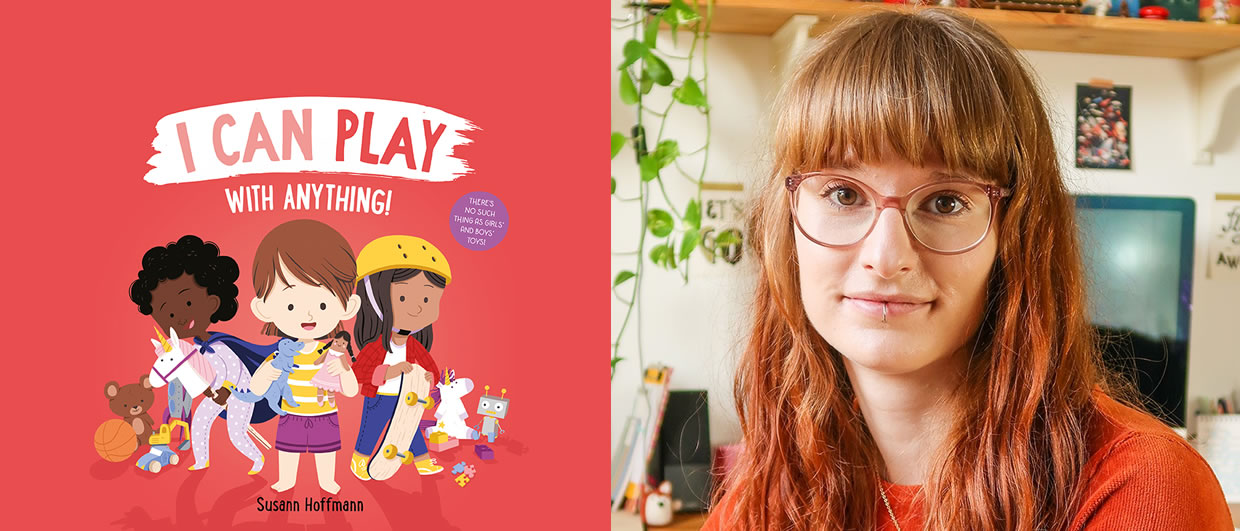2 new picture books that challenge gender stereotypes
Published on Wednesday, 10 March 2021
Last updated on Monday, 08 March 2021

Gone are the days when fairy wings were just for girls and trucks were toys for boys.
In this modern age, your under five is encouraged to wear what they like and play as they please, and Susann Hoffmann has created two picture books that empower children to rock that tutu, ride that skateboard and live their best life – free of gender assumptions.
I Can Wear Anything! and I Can Play With Anything! combine colour and fun with an important message, and to learn more, we spoke with Susann herself.
What inspired you to write these books for toddlers and preschoolers?
To be fair, I Can Wear Anything! and I Can Play With Anything! were planned and written in close collaboration with the team at Hardie Grant, and especially designer Pooja Desai.
These picture books aim to challenge the conception that there are certain types of clothes and toys that are just for boys or just for girls – instead, we want to show that clothes, toys and colours have no gender and are for everyone.
This is a topic that is close to my heart, not only because I believe it to be an important feminist issue, but also because of my own personal experiences as a child. I remember I often wished I had been born as a boy because then I would have been able to do the things I enjoyed without feeling ‘weird’.
One thing I’m particularly sad about is that I dropped skateboarding because it was such a male-dominated hobby and I felt so out of place – which is why I had to put skateboarding and roller-skating girls in the books!
I believe that this arbitrary separation into ‘male’ and ‘female’ categories is a pretty stupid idea. Why would we limit ourselves to only one half of the available clothes, hobbies, emotions and so on, when we can access them all?
How can parents help under fives to challenge old gender stereotypes?
First up, I need to say that I don’t have kids myself and wouldn’t dream of telling parents how to raise their children! Personally, though, I think that if we encourage kids to do what they enjoy, strengthen their self-confidence and feeling of self-worth, and lead by example, then that’s a good start.
Grown-ups need to challenge our own internalised stereotypes so that we’re careful not to reproduce them in front of children (by unintentionally making them feel ashamed for what they like, for example).
And, of course, we need to protect kids from toxic and harmful behaviour from others, and keep challenging traditional beliefs in others. This needs to be done in a respectful way, and simply asking “Why?“ or “Why not?“ can lead to surprising results.
I’m happy to see more diversity in children’s books, and media in general, even if the ‘pink and blue’ trend is still common, unfortunately.
Apart from your own books, what other children’s titles can you recommend to foster inclusivity and equality?
I like the simplicity of Pink Is For Boys, written by Robb Pearlman and illustrated by Eda Kaban. Each double page shows one colour and how that is perfect for both girls and boys.
I also appreciate Julian Is A Mermaid by Jessica Love. I find this book especially lovely because the boy’s grandma supports her grandson in his gender expression, which is sadly not a given.
There is also Love Makes A Family by Sophie Beer. This book represents a variety of families in a very subtle way, showing them just as they are – completely normal and loving.
Good Night Stories for Rebel Girls: 100 Tales of Extraordinary Women by Elena Favilli and Francesca Cavallo is also a great book to share with children who are a little older.
I Can Wear Anything! and I Can Play With Anything! are published by Bright Light – a new imprint from Hardie Grant Children’s Publishing which hopes to, ‘Change the world – one conversation at a time’. And you’re also the author of a Hardie Grant board book called Girls Are Pretty… How does it feel to be making a positive impact through your books?
I am so happy whenever someone tells me that they love my books! I’ve heard of children imitating all the children in my books; of kids wanting to build a block tower as big as the girl’s one; and of a little girl who always wants to be asked if she’s clever/fast/creative like my book character, so she can yell, “YEEEES!“ in reply!
It brings me joy to hear that the positive messages in my work are helping, if only a little bit, and my Hardie Grant/Bright Light books have brought me more happiness than any other project I’ve created.
Pick up some positive picture books
To browse Bright Light’s other ground-breaking titles, click here, and to buy Susann’s books, head to The Nile, Mighty Ape and where all good books are sold.
Related Articles

Books are still better for children than devices
Even in the age of digital technology books will always be better for children.

10 children's books with strong female protagonists
Female protagonists remain largely invisible in Australian picture books for young children, so here are 10 amazing books to redress the balance.

Kiwi authors celebrate the importance of children’s books
Four Kiwi author/illustrators explain what qualities make a great picture book, what books offer children and how to ensure maximum engagement while reading to children.
